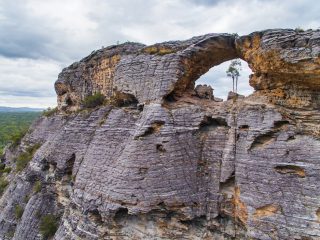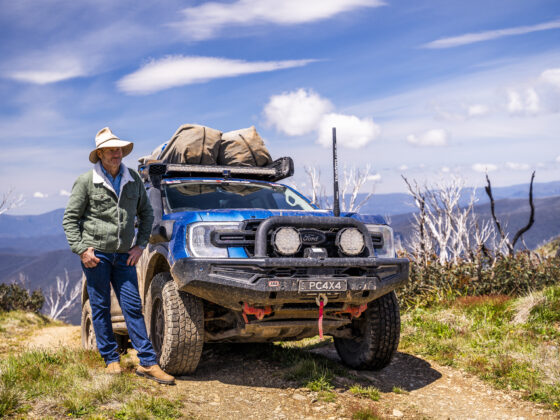Originally published in Issue 41 of Pat Callinan’s 4×4 Adventures, this article sees us exploring Carnarvon National Park which is a great place to visit at any time of the year.
Carnarvon National Park is located in central Queensland about 300km west of Rockhampton and 600km north-west of Brisbane. The Gorge and Mount Moffat are best accessed via Injune if travelling from the south. Salvator Rosa and Ka Ka Mundi are best accessed from Springsure, on the northern side of the park. It will take you a number of days (or weeks) to visit all areas.
- When to Visit Any time of year, although summer can get very hot. Autumn, winter and spring are probably the best choice for most people.
- Fuel and supplies Most of the larger towns have fuel and supplies. Take plenty of drinking water, otherwise you may have to treat tank or river water.
- Where to stay The Gorge section has the most accommodation choices with a well-stocked caravan park at Takarakka, or more self-reliant camping with spectacular views at Sandstone Park. Both are at the eastern entrance to the Gorge. The other camping areas within the park are more remote with drop toilets and water generally available from the creeks or perhaps a tank.
- Difficulty Good gravel roads when dry but roads are susceptible to rain and flooding so check the forecast before heading out.
- Websites www.npsr.qld.gov.au/nationalparks/
Spyglass Peak or The Tombs are not locations you will find in Carnarvon Gorge, but they are part of the same National Park. Most people have heard of Carnarvon Gorge in Central Queensland, and many of you have been there, I’m sure. I first visited as a teenager and have been back many times since. Last winter, I visited part of Carnarvon National Park that I hadn’t been to before.
Carnarvon is a bit like that; just when you think you’ve seen it all and start thinking of other places to visit, you realise there is more to it. Many people drop in for a few days on their way between the southern states and the tropical north. The Gorge is well located for this and provides an oasis among a sea of Mulga.
With Cycads dominating the landscape, Cabbage Palms stretching skyward and Platypus paddling quietly in the deep holes of Carnarvon Creek, the Gorge is a fabulous space to explore. The sheer cliffs of white sandstone reflect the sunlight into the main gorge. Slot canyons escape much of the light, encouraging bright green moss to cover their cool, dark surfaces that weave for hundreds of metres away from the main gorge.
Small Yellow Belly and Catfish ply the crystal-clear waters, fed from springs flowing from the many layers of sandstone. The water that emerges out of the rock fell as rain many thousands of years ago when the landscape was home to its original inhabitants. These cliffs also aid as a replenishment area for the great artesian basin, taking in water as well as releasing it.
Millions of years of water flow have eroded through the top layer of recent basalt (30 million years old) down through 600 vertical metres of sandstone to the uppermost layer of the Bowen Basin. This layer dates back around 240 million years and contains the world’s largest deposits of bituminous coal. You’ve probably heard about the Bowen Basin before.
It takes a few hours to climb from the gorge floor to the basalt capping, so most people spend their time enjoying the cool lush surroundings of the lower gorge. If you have never explored the Moss Garden or Ward’s Canyon, these are places you should visit. Ward’s Canyon is home to the very rare King Fern with its fronds up to five metres in length.
Water is responsible for another natural location not to be missed. The Amphitheatre is a spectacularly deep chasm with one small entrance through a narrow crevice. There is now a steep, steel ladder providing access to the entrance. Over the years, there have been many attempts to provide access, however all have succumbed to rock fall and rushing water. The current over-engineered staircase may just last the distance.
One of the most notable attractions of the Gorge is the abundance of Aboriginal stencil art that can be seen at some beautiful locations just off the main Gorge. The Art Gallery and Cathedral Cave are significant Aboriginal sites that remind us of the thousands of years of Aboriginal history when different tribes used to gather in the Gorge for special ceremonies.
Only 30km away as the crow flies is the Mount Moffat section of the Carnarvon National Park. It is there you can see the only known full-body stencil of an adult figure in the world. The meaning of the stencil has been lost long ago.
Aboriginal peoples first inhabited this cave over 9,000 years ago and for some other nearby caves, habitation goes back nearly 20,000 years. The area known as The Tombs was a place where deceased members of the Bidjara people were wrapped in burial cylinders of Budgeroo bark, before being placed in small rock chambers. Unfortunately, none of the remains are still in place, having been stolen by visitors over the last century.
The European history of the Mount Moffat area is that of exploration, cattle grazing and an infamous murder by the Kenniff brothers. They are said to have murdered a constable and station manager, before incinerating their bodies and packing them into saddlebags. The blood of the local Aboriginal Bidjara people also flowed during bloody massacres after clashes with settlers in the 1800s. The area has had both a violent human and geological past, which is belied by its now peaceful and subtle beauty.
Although geographically close, the drive between Mount Moffat and the Gorge is around 300km, which helps to explain the difference in visitor numbers. Mount Moffat requires a 4X4 to access the campsites and to explore the headwaters of Carnarvon Creek. The lack of visitors adds attraction as you may well have the place to yourself. We particularly enjoyed sitting quietly in Kookaburra Cave, listening to the sounds of the surrounding forest and feeling the natural space. Not far from here, is a tall orange and white pillar of sandstone rising out of the forest.
On the northern side of the Carnarvon National Park are two more sections, again a long drive from the Gorge. Travelling west out of Springsure, Ka Ka Mundi has an unimproved camping area with no marked walking trails. If you are willing to travel by foot across the untracked landscape, you are sure to be surprised by what you might find. Many of the rock overhangs have Aboriginal stencils that are aging with the forest and very few visitors.
A little further to the north-west is the Salvator Rosa section of Carnarvon. In July 1846, the explorer Thomas Mitchell described the landscape:
“The hills overhanging it surpassed any I had ever seen in picturesque outline. Some resembled gothic cathedrals in ruins; others forts; other masses were perforated, and being mixed and contrasted with the flowing outlines of evergreen woods, and having a fine stream in the foreground, gave a charming appearance to the whole country. It was a discovery worthy of the toils of a pilgrimage. … I gave to the valley the name of Salvator Rosa.” – Thomas Mitchell 1846
Mitchell described the landscape well and certainly captured the essence of the rocky hilltops. He didn’t name the oft-photographed Spyglass Peak with its 10-metre hole near its summit. Perhaps he refers to it as the perforated mass. The rock is fragile and not suitable for scrambling or climbing, lest you want a tumble worthy of Jack and Jill. Some tracks follow the base around Spyglass Peak and another with a short climb to the top of Homoranthus Hill that gives a tremendous 360° view of the surrounding hills. The hill has a strange name but is so named after the rare shrub with dainty pink flowers found on its flanks.
Nearby is the Louisa Creek Junction with the Nogoa River. It is a short walk from the car, and if you walk quietly, there is a good chance you will see some of the birdlife, including Egrets and Herons, feeding on the fish and frogs that enjoy the permanent water running from Belinda Spring.
The Carnarvon National Park is a must-see destination that provides visitors of all sorts a satisfying spot to explore. Be it short track walks or the six-day Great Walk carrying everything on your back, or a 4X4 trip out to Mount Moffat, there are definitely places you haven’t seen yet. The deeper into the park you go, the more you will want to see what is around the next bend or through the eroding sandstone arch.
“Travelling along the bank of this stream, we found it flowing, and full of sparkling water to the margin. The reeds had disappeared, and we could only account for the supply of such a current, in such a country, at such a season, by the support of many springs.” – Thomas Mitchell 1846
Carnarvon is a place carved and created by water, in the middle of dry land often gasping for water.

















